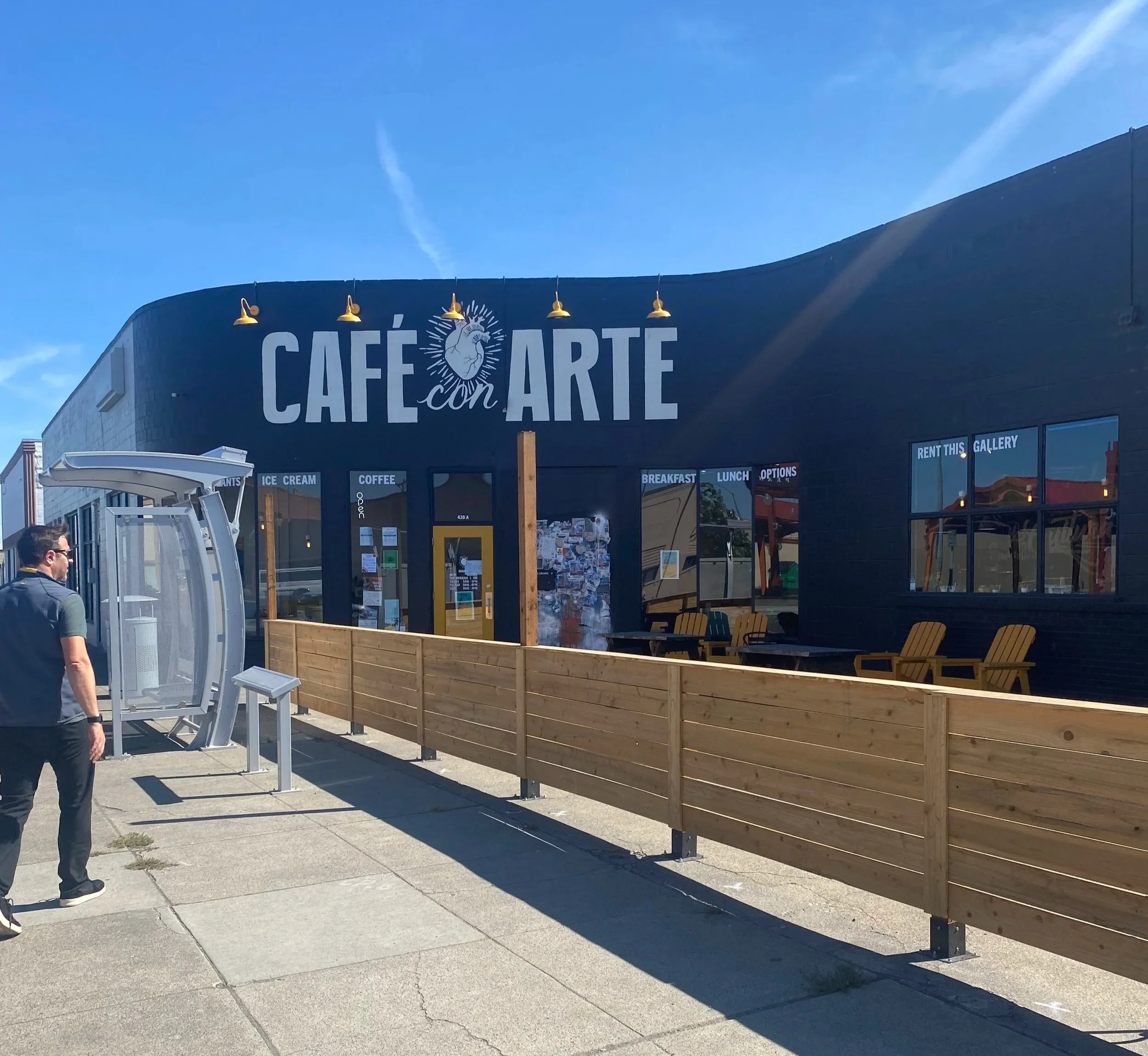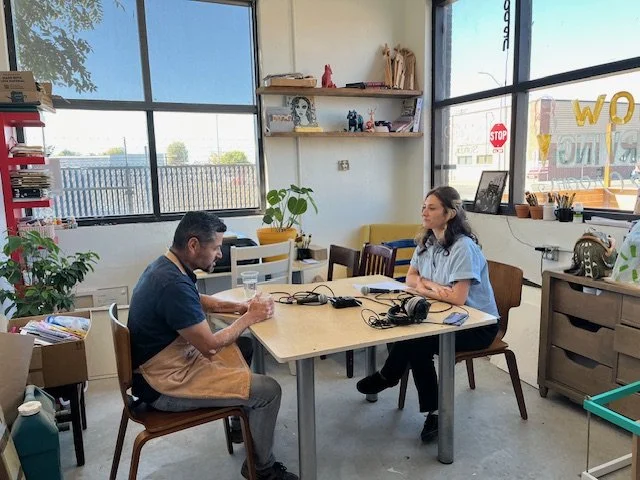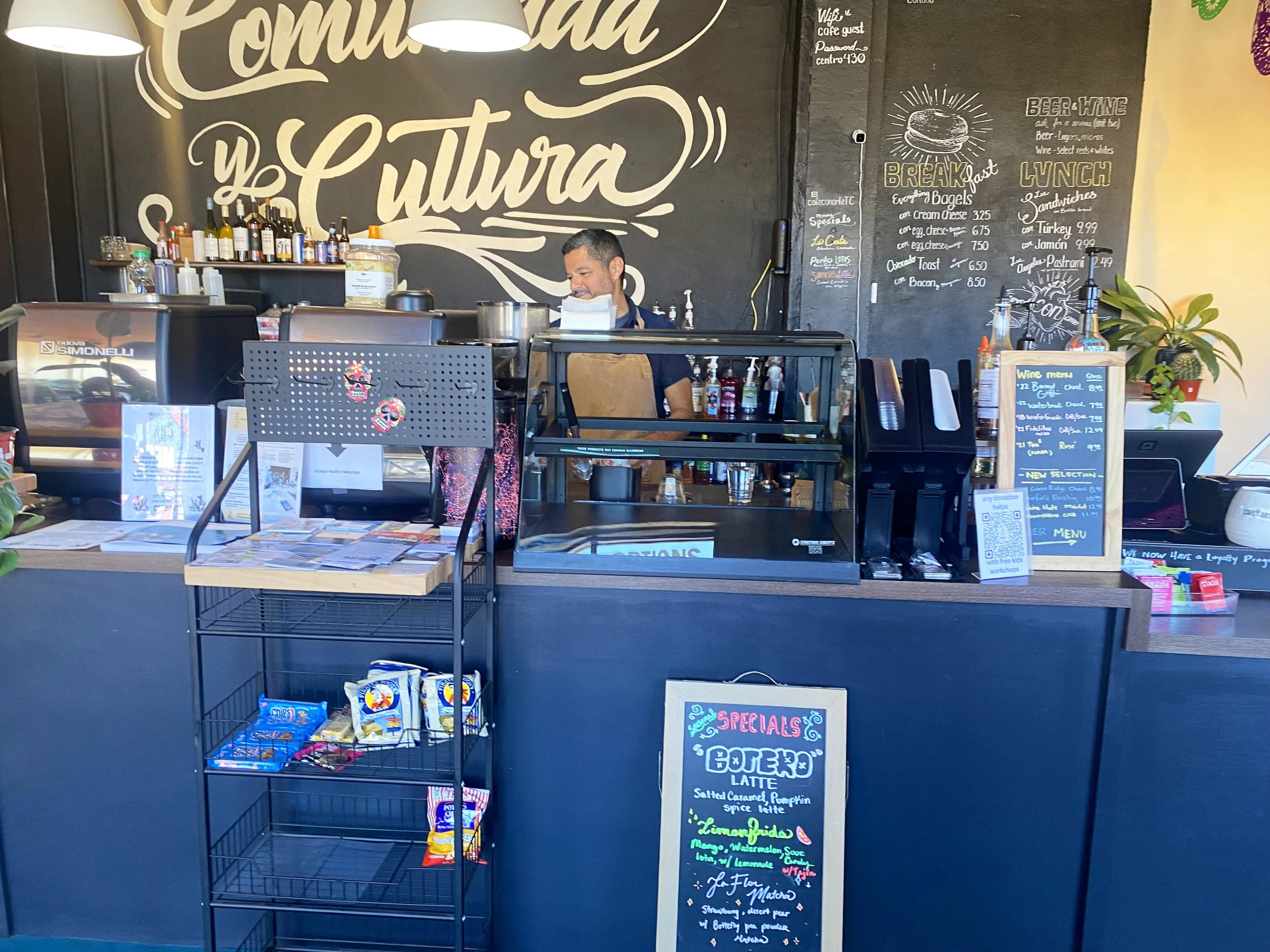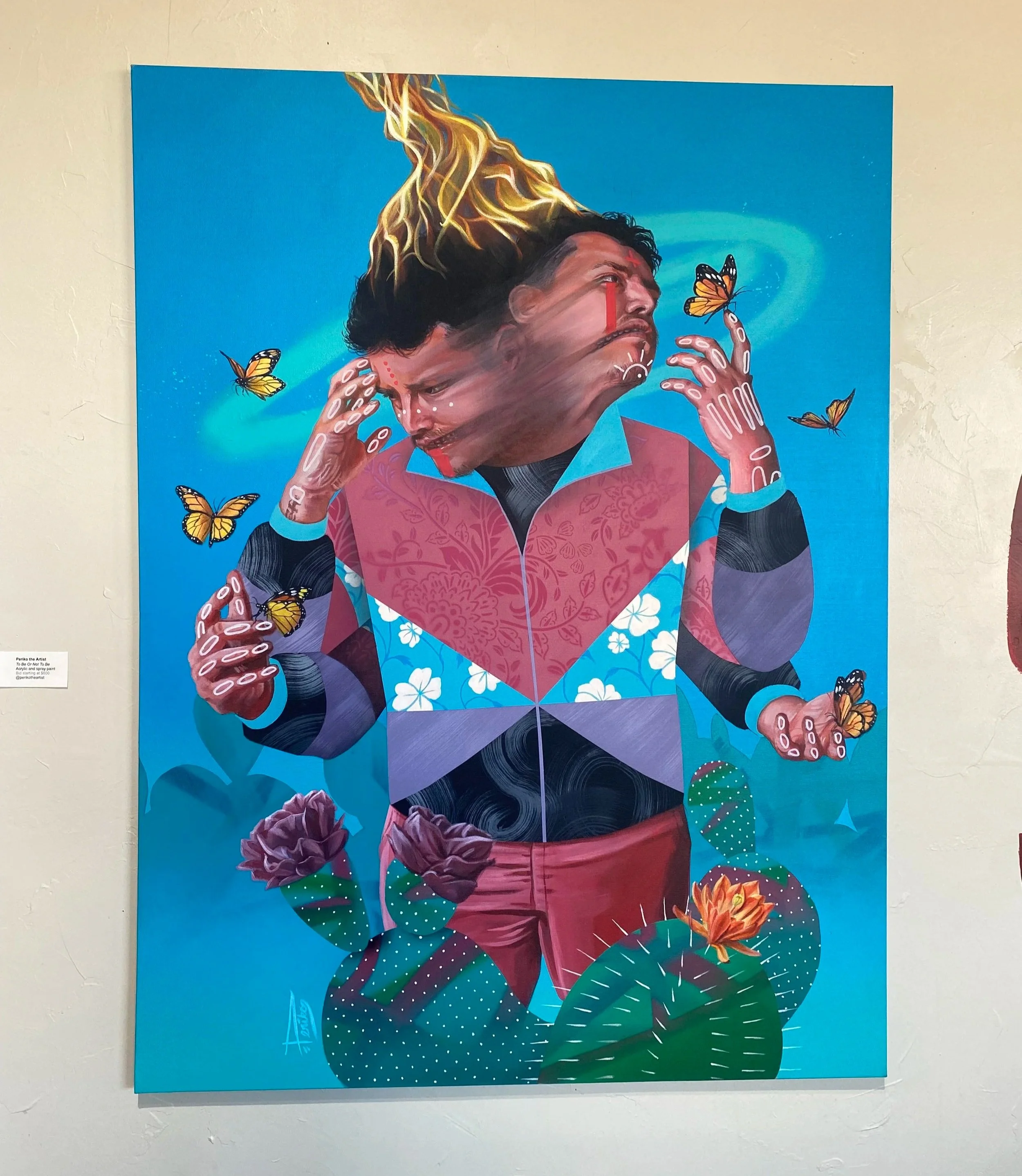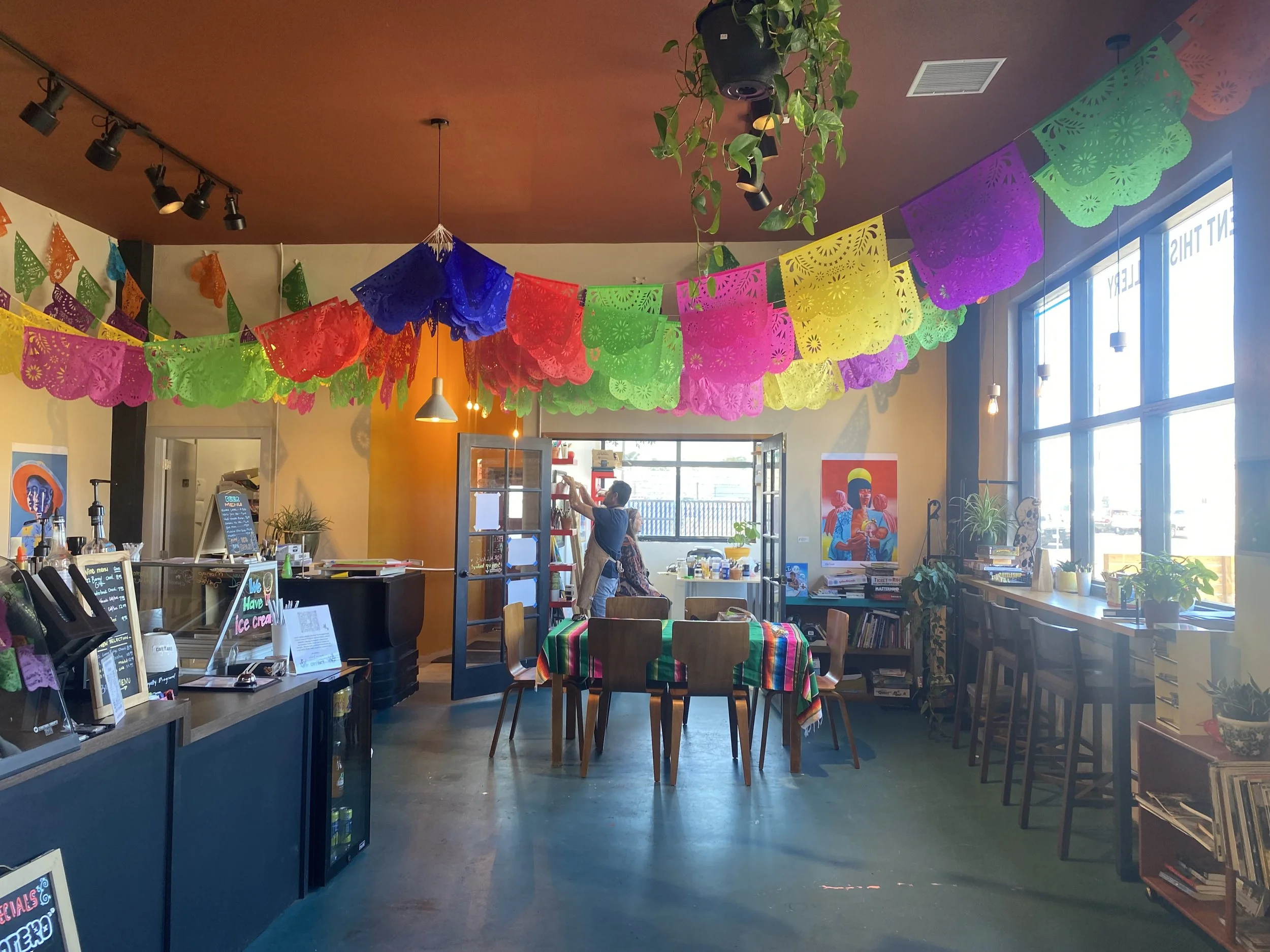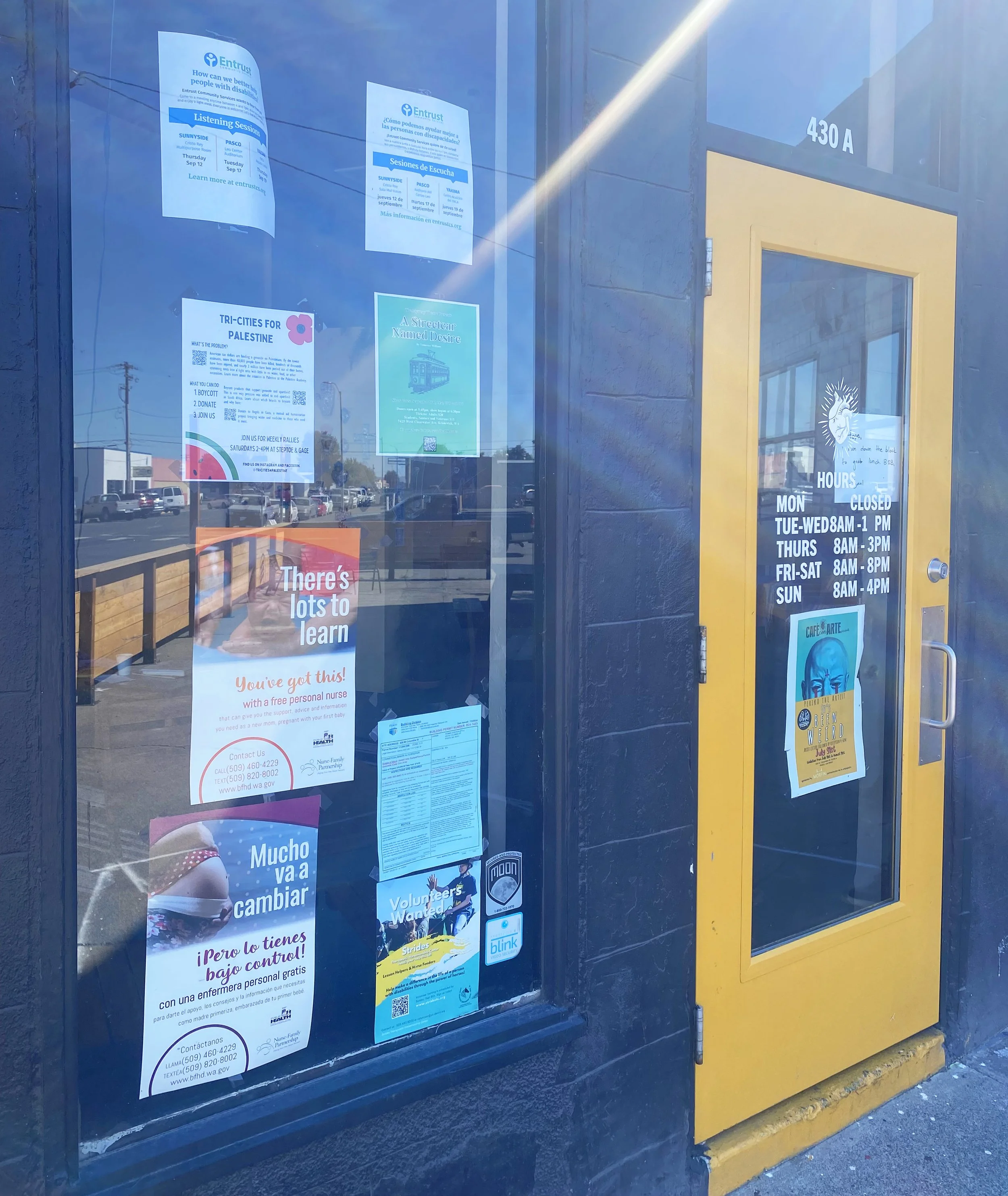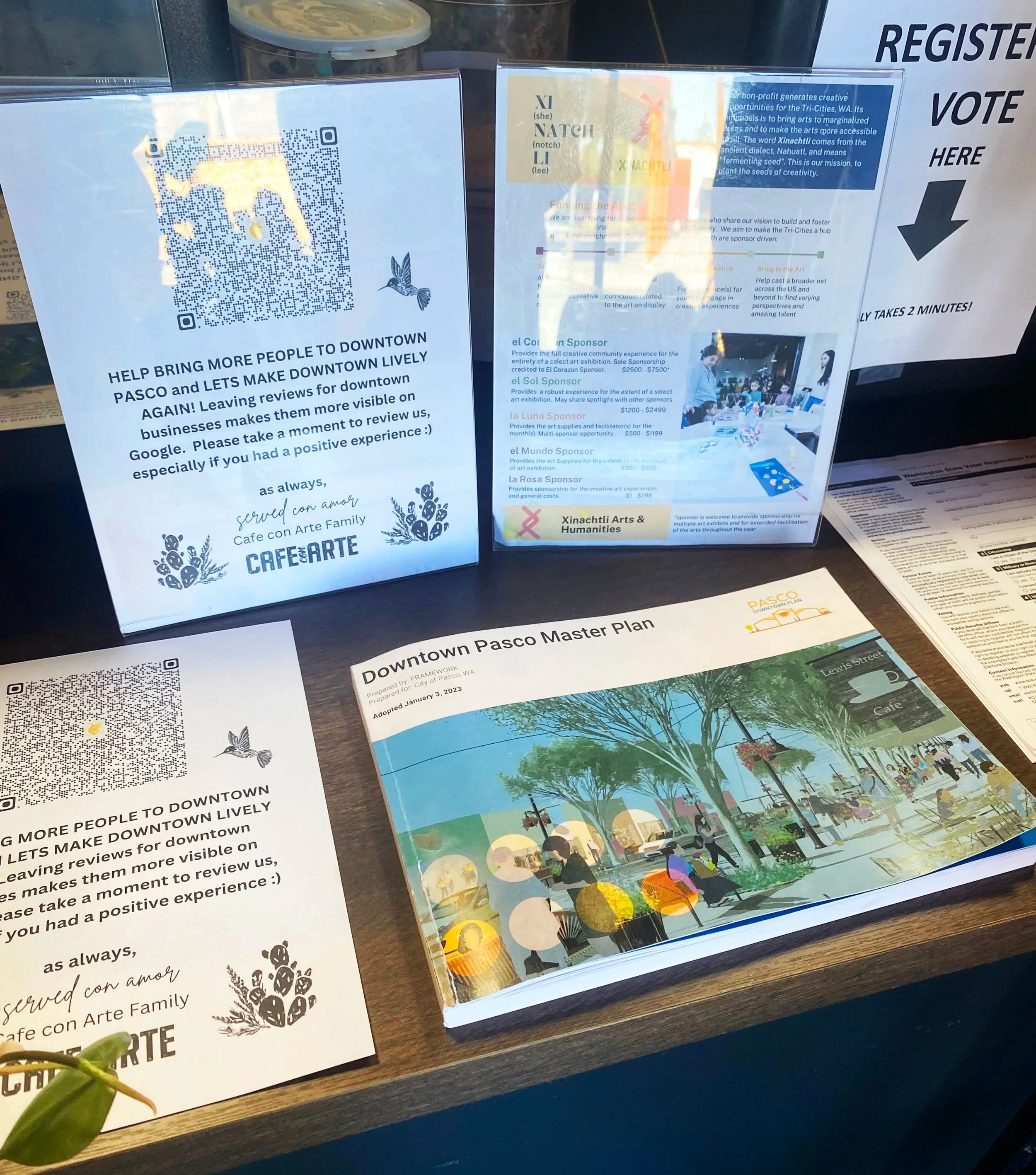making art downtown: a conversation with Pasco cafe owner Saul martinez
In the heart of Downtown Pasco lies a place where you can order a latte and leave with a new perception about what it means to create art. Owner Saul Martinez, art teacher and artist himself, has designed it that way.
Café Con Arte, was once a vacant building sitting right next to Peanuts Park, a flexible plaza and recent City investment. Every week, the plaza hosts the weekly farmers market, where hundreds of people buy and sell produce from eastern Washington's many farms. But during the week, it mirrors the rest of Downtown: it's a place that few choose to utilize, and some even avoid.
Framework's work to implement the Downtown Masterplan has been aimed at reversing this trend of inactivity through adaptive reuse of buildings, regular events, and better use of public space. Much of this work has been focused on updating codes and interpretations that create barriers. For example, when the Master Plan was adopted, a space like Saul's wasn't even legal — it took lifting parking requirements to allow the building to become a coffee shop. Of course, changing codes to allow new uses is just that start, and the community members like Saul, who are investing in Downtown Pasco, are at the core of its success.
We sat down with the cafe owner to talk about what drove him to quit a job where he could “finger paint all day if he wanted to” and plant roots in a Downtown that is struggling to ditch its reputation and blossom as a cultural hub. He talks to us about the potential for art to be a tool for youth empowerment in Pasco, and how he thinks the City could be support folks who want to take a chance Downtown. Enjoy an abridged version of our interview below!
Sitting Down with Saul
Saul cleared off a table full of art supplies to make room our recording equipment.
the origin of cafe con arte
FRAMEWORK:
You can introduce yourself however you want…
SAUL MARTINEZ:
My name is Saul Martinez. I am a Chicano artist and new business owner in downtown Pasco, Washington, which is on the east side of the state.
FRAMEWORK:
And we're here at Café con Arte, where you started this really cool thing in downtown Pasco. Can you talk about how this idea was conceptualized?
SAUL MARTINEZ:
Oh boy, those are kind words. I've been reflecting on this question a lot in the last eight months, and I used to just kind of simplify the answer to, "why not?"
I am an educator by trade, and so working with kids in this community, it just really broke my heart that they were embarrassed about the space that they were from — the East Pasco community.
When I first moved to Tri-Cities about 12 years ago, everybody was like, "Yeah, Tri-Cities is a great place to live and grow and raise kids. Just avoid East Pasco." And for the first two or three years, I actually listened to that advice. Even as a teacher here in Pasco, I would just never go to downtown East Pasco — until I did. And then it was just like, "Oh, why have I avoided it this whole time?"
It started with coming downtown more frequently with my art club. We were hanging Christmas lights and painting windows to beautify the area. And it was also just to put them out there so people could see that my New Horizons kids were amazing kids, because they are. I saw their aptitude. I saw their willingness to give back. It was just a beautiful thing.
There we would engage with all sorts of community members and leave with this impression of downtown Pasco as a diamond in the rough. Just somebody needed to activate it…
“The process that we use in the classroom—why can’t we use this in the community?”
From art teacher to cafe owner
SAUL MARTINEZ:
One thing that I noticed in my classroom was that the kids — even though they seemed to be proud of themselves — when they would talk, their body language spoke differently. You could see them walk down the hallways with a proverbial “tail between their legs.” They just seemed so embarrassed… My question in my classroom was: How do I change that? That was my focus mid-COVID.
I came to the realization that “dead art” wasn’t speaking to them. Why was I trying to teach them classical when all they cared about was hip hop, or country? So I started teaching them contemporary works, I started highlighting artists that were expressing their experiences in unique ways.
Immediately their conversations changed. They opened up a lot. They started talking about their own experiences. It was back and forth. No more monologue — we were having a conversation..
The process that we used in the classroom — why can’t we use this in the community? How can we further that conversation and start looking at ourselves through a lens of reverence, of being valued and celebrated?
That was that. Again, I went back to teaching and I thought that question would never resurface — until I met a person in the community named Alexia Estrada. Just a brilliant young lady with so much excitement about what this community could be.
She said, “I want a third space. I want a coffee shop in downtown Pasco.” We shook hands within the first 10 minutes and agreed that we were going to do something.
FRAMEWORK:
What I’m hearing is that you saw that contemporary art was missing from your student’s education but also from Pasco as a whole.
SAUL MARTINEZ:
Not missing, but maybe room for more.
If you look at more modern or previous art forms and movements, it was about capturing a moment. Contemporary art is more about speaking about our immediate needs — as individuals or as a community. It highlights what’s right, what’s wrong, and everything in between.
And as an artist, with great power comes great responsibility. It’s important to use your skill set to speak about the things happening in your community or beyond.
“‘Dead art’ was not really speaking to my kids. Why was I trying to teach them classical when all they cared about was hip hop, or country?”
“To Be Or Not To Be” by Periko the Artist, in acrylic and spray paint. Displayed at Cafe Con Arte in September 2024.
you caught me: I wanted a gallery
FRAMEWORK:
The room we’re sitting in has paper cups full of crayons, paint brushes, plants, chalk… Art is clearly happening here, it’s all over the walls. And before we started recording you cleared off the table, which had seemingly been the site of some kind of art making.
What’s happening here at Cafe Con Arte?
Saul Martinez:
You know, the big picture of Cafe Con Arte — I would call it a conceptual art piece.
If we go back to my kids and what I wanted them to see, I wanted to hold up a mirror and say, “Look at yourself. You are of value. You are worth anything and everything. You are visible, and I see you.”
I want that for the community, too.
FRAMEWORK:
From what I’m hearing, you saw this opportunity to nurture arts in Pasco, but you didn’t just open an art gallery, you opened a cafe…
SAUL MARTINEZ:
I wanted a gallery, you caught me. But I know what the art market looks like in the Tri-Cities, it’s almost nonexistent. You can count the galleries in the Tri-Cities – a population of 300,000 people – on one hand. How fair is that to a community? It’s embarrassing. I feel like it was a calling, a need. I wouldn’t say it was a dream, it was just like, I can’t go another day, another year, complaining about it. I have to do something about it.
The coffee shop? I have to pay the bills. In the Pacific Northwest, you can’t go a block without seeing a coffee shop, but drive around downtown Pasco and there were none. To me it’s a no brainer. And it’s just the beginning - I feel like, third spaces downtown – coffee, food, toys, games, books, events at night, that’s all going to be a part of it. It’s more than just coffee.
FRAMEWORK:
You’ve already been having art classes here, speakers… You’re doing a lot. What’s been the reception of those events?
SAUL MARTINEZ:
I’m trying a bit of everything… Just like we are teaching the community that we now have sit-down coffee in downtown Pasco, [we’re also] teaching people that paint-and-sips are a thing. People come in expecting paint-by-numbers, but that’s not what we do here! We’re gonna put you through a little stress because that’s growth, and you’re gonna love what you walk out of here with.
it’s time for us to be San Diego, Los Angeles, Santa Ana, Fort Lauderdale, or wherever… You can basically spin the globe, point, and find communities that have said enough! We can be who
we want to be!
PASCO’S IDENTITY AND VISION
FRAMEWORK:
Let’s talk about Pasco. Pasco has been working on changes downtown to make it a place where the culture is visible and people want to be. What makes Pasco’s culture unique?
SAUL MARTINEZ:
I think it’s the population, I think it’s the moment we’re in, where the community can choose what it wants to be. I don’t feel like it’s ever felt like it had the liberty to do so. For some reason it felt like it needed a top-down definition: This is who you are.
But with a 56% Latino demographic — maybe closer to 62% — it’s time for us to be San Diego, Los Angeles, Santa Ana, Fort Lauderdale, or wherever… You can basically spin the globe, point at it, and find communities that have said enough! We can be who we want to be! There’s no shame in that in fact, quite the opposite.
The Tri-Cities and Pasco, with this influx of transplants as well as people who have deep roots here, there’s this really cool opportunity.
FRAMEWORK: When you think about downtown Pasco and the changes you want to see, what does that look like?
SAUL MARTINEZ:
Vibrancy.
I want people to experiment with what a vacant lot can be. There’s so much repetition because it’s safe. I want people to take risks — throw that Hail Mary pass at a plant shop, or a tattoo parlor, an antique store — even if it might not work out in the immediate future.
People need those walking spaces between Café con Arte and the Italian restaurant right down the street. Another coffee shop, bring it! I think with more options, come more people, and more foot traffic… I welcome that.
I know what the art market looks like in the Tri-Cities, it’s almost nonexistent. You can count the galleries in the Tri-Cities – a population of 300,000 people – on one hand.
supporting third spaces
FRAMEWORK:
What could the city do to better support places like Café con Arte?
SAUL MARTINEZ:
Remove all restrictions. There are so many barriers, so many hoops to jump through. And when you get through those hoops you find mini hoops that you have to jump through.
There needs to be access – I’m sure there’s grants out there but as a one man show running Café Con Arte, by 11:30 or 12 a.m. when I’m done book keeping and it’s time to look for grants, I find myself asleep on the couch. There’s never enough time.
It would be great if someone had all the resources. I feel like a lot of organizations are doing similar stuff but they’re not connected.
And then there are the vacant lots — I can point to six vacant lots over here, three right next to me. I don’t think that attracts culture. I think we need to have these spaces filled, so looking at Vacancy Tax, or something like the program “Vacant to Vibrant” in San Francisco.
I think the City needs to be loud and clear about what they hope for from the community. I think they need to tell us that they’re stepping aside for creatives. I think we all have this creative nature about us, we are innovators. We just need to know that it’s a safe space for us to do so.
I have major faith in this community. There’s a lot of excitement and buzz around what Framework is helping to do and I think it’s only a matter of time.
“I think the City needs to be loud and clear about what they hope for from the community. I think they need to tell us that they’re stepping aside for creatives. I think we all have this creative nature about us, we are innovators. We just need to know that it’s a safe space
for us to do so.”
the plan
A copy of the Downtown Pasco Master Plan sits on the counter at Cafe Con Arte, reminding visitors that there is much in store for the future of Downtown.
Written by Hope Freije @Framework
SDf 2024 - seattleites find belonging in third places
Third places are glimpses into understanding how we build community in cities. For us at Framework, our 2024 Seattle Design Festival (SDF) installation starts a larger exploration of how urban planners and designers can foster “civic soul,” third places often being the places where this soul grows and thrives.
On August 17th and 18th, 2024 we displayed our installation “Postcards to Third Places” at Lake Union Park as part of the SDF. Over two days, we invited the public to share their appreciation for their favorite Seattle third places – the gathering spaces and incubators for art, creativity, and community care that are essential to urban life in Seattle. We wanted to get the community talking about our favorite local third places, express the value these places bring to our community, and offer people a way to share some love with their third places.
For a deeper discussion on the concept that inspired our installation, check out our last blog post.
Postcards to Third Places
Our installation for Seattle Design Festival 2024 asks visitors to write postcards to local community hubs.
An evolving installation
Throughout the weekend, visitors hung their postcards for all to see.
designing our “third place”
Our installation aimed to create a temporary, homey space for hanging out, having dialogue, and reflecting on the impact of third places in our lives.
The construction of the installation was an opportunity to work sustainably and promote Seattle-based third places in the process. Donated from Ballard Reuse, recycled doors formed the base of our installation. The doors displayed postcards designed by the public during the festival and framed a temporary “third place” environment.
We risograph printed our postcards at Paper Press Punch, utilizing a unique printing method that made each of the postcards special with a hand-printed and tactile quality. Festivalgoers could decorate their postcards with custom stamps, drawings and stories of what made their favorite third place special to them.
House of Doors
To build our installation, we repurposed doors donated from Ballard Reuse. We love that the mix and match style of doors speaks to the character that develops in third places over time. Together, the doors attached together create a temporary, mini-third place, a place where Seattle Design Festival goers could gather and write postcards to their beloved community hubs.
Where are our third places and what do they mean to us?
Over two days, the public wrote and decorated over 200 postcards in appreciation of their favorite spaces for food & retail, outdoor and indoor recreation, arts & culture experiences, and community resources like libraries and religious spaces. Amongst the most popular third places were Elliot Bay Book Company; the Ballard Farmer’s Market; Garfield Play Field; Schultzy’s Bar and Grill; Magnuson Dog Park and many of the Seattle Public libraries.
Throughout the festival, we had conversations with individuals who helped us understand what value third places bring to their own lives, and what makes these places essential to the community. Here are some highlights:
Third places can be places of respite, providing safe and comfortable spaces to unwind and relax. Some Seattleites have found these spaces in independent retail spaces, like the “Relaxation that comes from going through old records and CD’s” (written to Al’s Music Video & Games, U-District). Others in community spaces where they can be active. For one festivalgoer, the Central District’s Meredith Matthews East Madison YMCA is, “the perfect place to go when [they’re] overwhelmed, and the place to swim with [their] best friends.”
In our changing climate, respite is coupled with the need for refuge from extreme weather. One participant mentioned, “I work from home but when it gets too hot, I have to go elsewhere.” For this reason, they’ve found much-needed relief at Stoup Brewing in Capitol Hill.
Engaging with kids
Seattle Design Festival draws a lot of families, and we wanted to make sure our activity was kid-friendly. We created stamps that allowed people of all ages to customize their postcards.
Being Creative Together
Seattle Design Festival attendees sat at a cafe table and customized postcards.
One third of postcards were written to outdoor recreation spaces around Seattle, which included public parks, streets and plazas and natural areas. Appreciating natural beauty is often a primary value to Seattle’s favorite third places - like at Elliot Bay Park, on the Expedia Campus, where Seattleites go “to watch sunset and picnic and spot some seals.”
What often emerged from our conversations, was the issue of equity in third places: Who can access certain third places? Who cannot? And how does accessibility and inclusivity shape our favorite Seattle third places? With nearly 40% of the postcards written to private food and retail spaces, the issue of privatization and accessibility in third places is at the forefront. Access to these third places requires you to spend money, and may discriminate against the unhoused and otherwise struggling.
However certain third places were recognized for countering this status quo. “The affordability of donation-based and free Sundays and exposure for art students and art at large,” makes the Henry Art Gallery in U-District a preferred third place for many. In a similar vein, places like the KEXP Gathering Space are celebrated for cultivating inclusive environments for working and gathering, as described by one festivalgoer. Third places are spaces of belonging and interacting with our diverse community, especially for members of marginalized populations who might face difficulty finding solace in their daily routines.
Crunching the numbers
Different colored postcards corresponded with different third place types: Food & Retail (cafes, bookstores, markets, etc.); Outdoor Recreation (public parks, streets and plazas, natural areas etc.); Arts & Culture spaces (music venues, art & science museums, performing arts, etc.); Indoor Recreation (public pools, fitness studios, roller rinks, etc.); and Community Buildings (libraries, community centers, religious spaces etc.).
Mapping third places
In addition to writing postcards, visitors to our installation also pinned their favorite third places on a map of Seattle.
What remains clear is that Seattle third places are meaningful spaces for building community, whether that means running into familiar faces, meeting new friends, or serving as a central meeting point or neighborhood watering hole. At the Rainier Beach Community Center, an educator appreciates the opportunity to unexpectedly, “run into [their] students and their families.” Another participant mentioned how they, “met a whole group of friends [at the Seattle Bouldering Project] while climbing every Sunday”. In Downtown Seattle, Inside is a transformative arts studio and event space, and one postcard writer’s “favorite place to build community and to feel like [they] belong.”
Ultimately, a third place is somewhere we feel cared for - “Thank you for always being welcoming and taking care of me and my bike” someone writes to Good Weather Bicycle & Repair Shop, in Capitol Hill.
Framework team members relax after assembling the installation.
Written by Leila Jackson @Framework
postcards to third places
As Urban Designers and Planners, we’ve spent a lot of time recently thinking about how cities in Washington can prepare for the population growth that is expected to occur in the next 20 years. Front and center in these conversations are elements like land use, housing, transportation, and other infrastructure that makes the city tick. But when we talk to cities about their goals, it’s often the intangibles that weigh heavy on their visions for the future–“a city with character,” “a vibrant community,” “a thriving metropolis of arts and culture”…
At the same time, we’re seeing conversations about the disappearance of third places and the trend towards loneliness and disconnection from community. As cities like Seattle grow, rising rent prices and the pressures of development can squeeze out places that act as vital hubs for art, culture, connection, and community. This loss is apparent through projects like Vanishing Seattle, “a media movement that documents displaced and disappearing institutions, small businesses, and cultures of Seattle - often due to development and gentrification - and celebrates the spaces and communities that give the city its soul.”
The disappearance of third places is not unique to Seattle, nor is it a new issue. As far back as the 1990s, Sociologist Ray Oldenburg was recommending that urban planners course correct away from the disparate suburban pattern designed to “protect people from community rather than connect them to it.” He argued that people need third places–or places outside of the home (“first place”) and office (“second place”). These neighborhood hubs, he wrote, are vital for fostering civic engagement, creating webs of mutual aid, and allowing people to experience the “joy in living” that comes from enjoying the company of those who live and work around you.
Postcards to Third Places
Our Seattle Design Festival installation will invite visitors to customize a postcard for a beloved community hub.
Nurturing our third places
It’s hard to imagine a “vibrant” city that doesn’t have third places. Meeting new people, exchanging ideas, creating together… It all requires space, not to mention the need for a public realm that allows people to put the fruits of community on display. So why are these qualities so hard to plan for? Why, decades later, are we facing the same problem?
Sometimes we try to solve problems with data: Can we quantify the economic benefits of a third place? Can we convince decision makers that protecting community does indeed pencil out? Can we determine a third place formula that can be modeled, replicated…?
Sure, maybe. But if third places teach us anything, it’s that community solidarity is a powerful force. So what if we started by talking about our third places, learning about the places that other people hold dear, and sending those places some love?
The vision
Using recycled doors and cafe tables, our installation aims to embody the spirit of a third place, where DIY elements signal community participation in a space, and add beloved character.
Seattle design festival
Postcards to Third Places is an installation that invites participants to “send love” to their beloved community hubs in the form of a risoprinted postcard. This project will debut at Seattle Design Festival, where we’ll carve out our own temporary “third place,” an installation made of recycled doors and cafe tables. Visitors will customize their postcard and mark the location on a map, telling a story of the places that Seattlites hold dear. Finally, we’ll send the postcards out, a small act of love for these community institutions.
This festival won’t be the first or last time we contemplate how urban planners can advocate for and create cities that allow culture to thrive. After the festival, we hope to connect with many of these Seattle third places to learn more about how they’ve survived the pressures of the last decade. Stay tuned for blog posts with interviews with these community institutions, and reach out to us if you know someone who we should get in touch with!
Creating our third place installation
Donated from Ballard Reuse, recycled doors form the structure of our third place installation, and will be used to display postcards created by guests..
Written by Hope Freije @Framework


